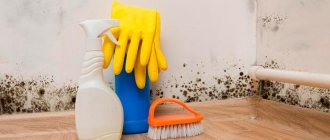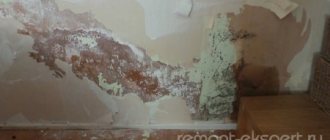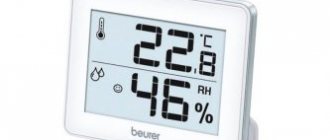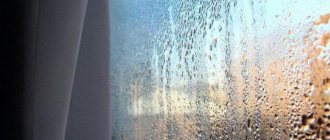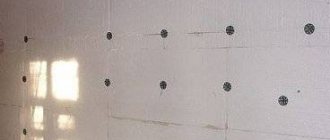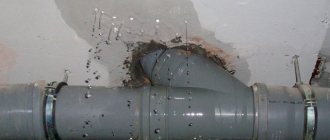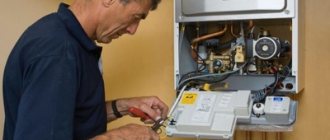When the humidity in your home exceeds the norm, you need to do something about it immediately. Some people live without paying attention to it, but this is a big mistake, since excessive humidity in the apartment can provoke the appearance of various diseases. A humid environment is ideal for the growth of fungus and other pathogenic bacteria.
In addition, an unpleasant musty smell may appear in the house, which over time will permeate all the furniture, linens and clothes. You can avoid such problems by knowing how to reduce indoor humidity.
Humidity standards in residential premises
Before you try to get rid of humidity in your home, you need to measure it.
The relative humidity in the living area should be between 40–60%. To measure it, a device called a hygrometer is used. There are several types of hygrometers, but for an apartment it is most convenient to use the electronic version. Using such a device, you don’t have to do anything, just monitor the indicators.
How to reduce indoor humidity
A kitchen hood significantly reduces humidity throughout the entire apartment.
To bring high humidity back to normal, do the following:
- On sunny days, open the curtains to allow light into the room. Avoid placing flowers that are too bulky on windowsills.
- During the hot season and in the frosty winter, the air outside is dry. Therefore, you should ventilate the room as often as possible, and the humidity will decrease. The ideal option would be to ventilate 3 times a day for 30 minutes. And at night, leave the windows ajar, at least in the kitchen.
- Check ventilation. If it is faulty, it should be repaired, as it will be a good assistant in the fight against dampness.
- If you have an air conditioner, you can use it to reduce humidity; there is a special function for purifying and drying the air.
An air conditioner with a drying function or special dehumidifiers will help combat high humidity.
- Household heaters will also help overcome dampness. They quickly not only heat the air, but also dry it.
- Certain building materials contribute to low humidity. This is wood and drywall. By covering the walls with them, you will adjust the hygrometer readings. And also use waterproofing plaster. It is completely waterproof and can withstand water pressure up to 5 meters deep.
- Dampness will also be eliminated after insulating the external walls. Unless the cause of this very dampness is a flooded basement.
- In the kitchen, a kitchen hood will help remove excess moisture. It should be used every time during cooking. If there is no hood, cover the pots with lids.
- A slight reduction in air humidity can be achieved using a hairdryer, candles and indoor plants.
- Dampness in the closet can be overcome by ironing clothes with a hot iron.
In the apartment
Recommendations for reducing air humidity in an apartment are similar to useful tips for houses and cottages. The only difference is that it is easier to establish a microclimate in the apartment due to its smaller size.
Steps:
- Selecting and installing an air dryer. The cost of equipment depends on the country of manufacture, its capacity and model. Dehumidifiers are sold in hardware stores, as well as in consumer electronics hypermarkets.
- Buying a heating radiator is especially suitable for apartments located in cities with constantly high humidity.
- Ensuring a flow of fresh air - as in the case of private houses, the apartment must be regularly ventilated. This can be done 3-6 times a day. It is advisable to leave windows open for at least 10 minutes.
Among the folk methods of dealing with excess moisture, one can recall the use of salt and sugar. Previously, when additional equipment in the form of dehumidifiers and heaters was not available to the general population, people used improvised means. They poured sugar or salt into large containers and placed them around the apartment. Due to their flowability, salt and sugar perfectly absorb moisture. However, this method is now outdated, and it can only be used if other options are not available.
We recommend that you read: Cellar ventilation
Folk recipes
Salt and sugar are highly hygroscopic.
In addition to the methods listed above, there are also folk recipes that will help eliminate dampness in your home:
- If there is high humidity, you can place containers with salt, sugar, calcium chloride, charcoal or quicklime in the corners of the room. These substances are highly hygroscopic, therefore, they will quickly absorb excess moisture. Such containers need to be changed periodically.
- When humidity is high, bricks will help. It would seem, how to reduce humidity with bricks? Very simple, but only if there is a man in the house. The bricks must be heated and placed on a fireproof tray, near the moldy wall. This must be done until the dampness goes away forever. But it should be remembered that after the tenth heating, the bricks will no longer absorb moisture. Be sure to follow safety precautions when using this method. There should be no flammable things near the bricks.
- You need to clean a damp apartment using “drying” agents. This could be bleach, potassium permanganate solution or vinegar. After you have wiped all surfaces and floors, you should once again “walk” through these places with a dry cloth.
When using silica gel to reduce humidity, be careful if there are small children in the house.
- When high humidity in the apartment makes it difficult to live, use silica gel. This is the kind of product that can often be found in small packets in shoe boxes. They can be purchased in large quantities at pet stores, as they are used in cat litter. Spread this product around the apartment, you can also pour it under the bath. Only use silica gel if you do not have small children who might eat it.
- You can get rid of mold by using this solution. Dissolve salicylic acid in alcohol and dilute with water. Apply the solution to the pre-dried wall. This will help destroy the gray mold patches and dry out the air a little.
- Copper sulfate will also help fight mold. Gray traces must be scraped off and the wall treated with copper sulfate solution. It can be replaced with bleach, bleach, vinegar, soda or soap solution.
How to get rid of humidity in an apartment using a special device
If your hygrometer readings are off the charts and you are wondering how to remove humidity in your home, special equipment can help. In stores you can find a device called a dehumidifier or dehumidifier.
Excessively humid air passes through a special evaporator. The temperature inside is lower than in the room. Due to this, the moisture turns into condensation and flows into a container intended for this purpose. And drier air enters the room.
The main reasons for the increase in indoor humidity
The reason may be poor-quality waterproofing of the walls of the house from the foundation. This happens due to a violation of technology during its construction. In such a situation, it will be difficult to get rid of the problem, since such construction defects are practically irreparable, but it is still worth finding out how you can remove the humidity in the apartment in order to improve living conditions.
The most common cause of excess humidity in rooms is a violation of natural ventilation. Often, after replacing old windows with new, more airtight double-glazed windows, dampness develops in the apartment. This usually happens due to a violation of air circulation, which causes humidity to appear, which condenses on windows, walls and even provokes the growth of mold.
There is another source of increased humidity in the apartment - the release of water into the air when family members breathe. And we are talking here not about milliliters per day, but about liters. Therefore, you should definitely find out how to remove humidity in an apartment, otherwise you will not be able to avoid negative consequences.
In addition, constant drying of laundry indoors can worsen the humidity situation. Another factor that increases moisture is heating. Moreover, even when the radiators in the room do not heat well, dampness may appear.
If the roof of a house is leaking, then high humidity can be eliminated only after it is repaired.
Useful tips for prevention
- Do not dry clothes in the apartment. It is better to do this outdoors, on the street or balcony. If this is not possible, you can purchase a washing machine that has a “drying clothes” function.
- After taking water procedures or hand washing, ventilate the room.
- When purchasing plastic windows, give preference to options in which the frames are equipped with a ventilation system, since it is plastic bags that do not allow air to pass through.
- If you have an aquarium, decorative fountain or indoor waterfall, it is better to abandon them.
- If you like indoor plants, it is better to purchase those species that do not require frequent watering, such as cacti.
Quality air in your home has a beneficial effect on your health. Knowing how to reduce humidity in an apartment and maintaining these indicators within normal limits, you provide yourself and your loved ones with comfortable living conditions.
Did you like the article? Was she helpful?
What are the dangers of high air humidity?
Excessively humid air can cause furniture and doors to deteriorate, wallpaper can change color, mold and peel off, and plaster can become damp and fall off. In a word, the end of the renovation.
Dampness even penetrates into closets - into all your important documents, valuable books and equally valuable leather boots.
Things made of wood, paper and leather are the first to deteriorate from dampness.
But the worst thing is not even this, but the fact that air with high humidity is a paradise for mold and mildew spores. In a damp room they multiply at tremendous speed. Through the respiratory tract they enter the human body, where in the “best” case they provoke allergic reactions and a runny nose. At worst, they spread through the blood to all organs and cause exacerbation of chronic diseases. Dampness is completely intolerable for asthmatics: they are overcome by attacks and coughing.
All people with weak or fragile immune systems, especially young children and the elderly, are at risk. In the latter, in conditions of high humidity and constant contact with damp clothing, furniture, and bedding, rheumatism can develop and progress.
There is one more point that is often forgotten. Increased humidity in a room is often a consequence of poor ventilation. Then stuffiness is added to the dampness itself, and we feel doubly uncomfortable. Poor ventilation leads to excess carbon dioxide CO2 in the air. And high CO2 content causes lethargy, fatigue, and reduces concentration and attention.
Even in modern housing, there is often a need to get rid of high humidity in the apartment. Such a microclimate is not only unpleasant, but can cause various problems, including human health. Dampness causes mold to appear. It causes people to develop allergies and feel unwell. The fungus also affects the aesthetics of the room, and it can be quite difficult to remove.
Normal humidity level in an apartment and how to measure it
The normal level of moisture vapor content for different rooms may differ slightly, but in general its value should be at the level of 40-60%. For the work area, office and library, a humidity of 30-40% is more acceptable. In the bathroom and kitchen the level will always be higher.
